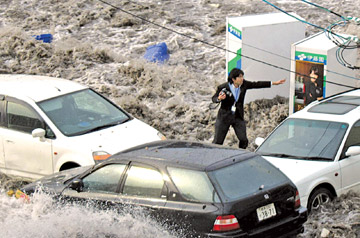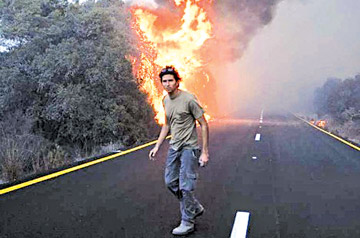|
Reporting tips in the face of calamities:
Uncovering facts while covering disasters
Gaston DE ROSAYRO

Toya Chiba, a Japanese journalist with his camera still in his
hand, during the 2004 Tsunami |
 |
| Journalists
are often among the ‘first responders’ when a calamity strikes |
Disasters are horrible events. But for reporters they are also
incredibly exciting. Sleep? There will be time for that later. Right
now, as the Yankee journalists would say: “You’ve got one helluva story
to cover!”
Accidents and disasters – everything from plane, train and road
crashes to earthquakes, floods, tornados, terrorist attacks and tsunamis
– are some of the hardest stories to cover. Along with professional
medical and emergency crews, journalists are often ‘first responders’
when a calamity strikes. Large-scale catastrophes challenge reporters on
the ground and newsroom editors alike, both in the midst of a breaking
crisis and often for months or years afterwards.
Reporters at the scene must gather important information probably
under very difficult circumstances. And they must often produce stories
on extremely tight deadlines. Covering an accident or disaster will
require all of a reporter’s training and experience. A word of warning
though: All disasters are tough to cover.
That is because many of them are chaotic and spread often out over
vast areas. The good thing is that you rarely if ever cover such stories
alone. Events such as these require teams of reporters deployed far and
wide in order to chronicle as many aspects of the story as possible.
Calamities are always stressful. After all, a disaster could mean
something horrible has happened on a very large scale. Many of the
people at the scene, especially victims, will be distraught. It is the
reporter’s job in such a situation to keep a clear head and remain calm.
You simply can’t afford to lose your cool when covering events like
these, as stressful as they are. Remember, it is your job to keep your
composure and calmly convey information that informs and maybe even help
people caught up in the vortex of such situations. You can’t do that
effectively if you lose control.
Be aware that in such a situation you will also often have to take in
a lot of new information very quickly. For instance, you may not know
much about different kinds of helicopters and planes. But if you are
suddenly called upon to help cover a plane crash, you will have to learn
as much as you can about the model and other technical details of the
ill-fated aircraft.
Take detailed notes about everything you learn, including things that
seem insignificant. You never know when minutiae might later become
critical to your story. Be aware of your surroundings, take in the
ambiance of the location which you certainly need for your descriptive
narrative. Readers will expect a vivid picture in the aftermath of
tragedy. Include the drama of the screeching sirens and the flashing
lights of emergency vehicles as they converge on the scene. Note down
the tumult, the disorder, the sounds, the smells that will be sketched
into the canvas of your final mosaic. The journalist must at the time
think of himself as a camera recording every visual detail that will go
into making up his or her dramatic montage.
In the aftermath of a disaster there will usually be dozens of
emergency crews on the scene – firefighters, police, and paramedics
among others. Find the person in charge of the emergency response. Even
at an early stage such an official will have the big-picture overview of
what is happening and will be a valuable source of information.
Also get quotes from people who were there and saw with their own
eyes what happened. Eyewitness accounts are invaluable for a disaster
story. It would not always be possible to interview survivors of a
disaster immediately after the event. In most cases they will be
undergoing treatment by emergency medical personnel or being debriefed
by investigators. But if survivors are available, try your best to
interview them. But remember, disaster survivors would have just
survived a traumatic event. Be tactful and sensitive with your questions
and general approach. And if they say they don’t want to talk, respect
their wishes.
In nearly every disaster there are heroes who emerge, people who
bravely and selflessly jeopardise their own safety in order to rescue or
help others. Find those people and interview them. Disaster stories are
often about numbers, how many people were killed or injured, how much
property was destroyed. Remember to gather every bit of information for
your story, but only from reliable sources, who will be the officials in
charge at the scene.
As you do your reporting, remember what is critical to any news story
– the who, what, where, when, why and how. Keeping those elements in
mind will help ensure that you gather all the information you need for
your story. So you have now done your reporting at the scene of an
accident or disaster and now it is time to write. You have a lot of
information to assemble into a coherent news story, and you are facing a
deadline. Here are some tips that can help.
Essentially it would be best to keep your story simple. Reporters
covering disasters sometimes make the mistake of trying to get too fancy
or complicated with their writing. After all, they have just covered a
huge story, and they want to make the story sound as important as it is.
But fundamentally, disaster stories do not need to be embellished by too
clever writing. The facts usually speak for themselves. Just tell
readers what happened, in simple, clear prose.
Your story starts from your lead which is basically your
introduction. So once you have found your opening bar the rest of the
story may come more easily. But a disaster story typically has lots of
elements, and too often reporters try to cram too much information into
their leads. Remember the lead is in essence the story in broad
brushstrokes. It does not have to include every detail. Because you can
include all aspects as you go along writing the rest of the story.
Quotes from disaster survivors, eyewitnesses or rescue personnel are
often the most compelling part of a disaster story. Pick a few of your
best quotes and put them up high in your story. They will be sure to
grab the reader’s attention and convey the drama of the event. A
disaster is a series of actions that unfold over time. They can happen
in seconds or take several hours. But a chronological account of what
happened will give your readers a better insight to the event. So be
sure to include that in your story.
Ensure you focus on the human interest element which as you will know
are people. Because in the end what is most important is how the tragedy
has affected real people. Keep the human element running throughout your
story. Focus on the victims, eyewitnesses and emergency responders. They
will bring the story to life. |



